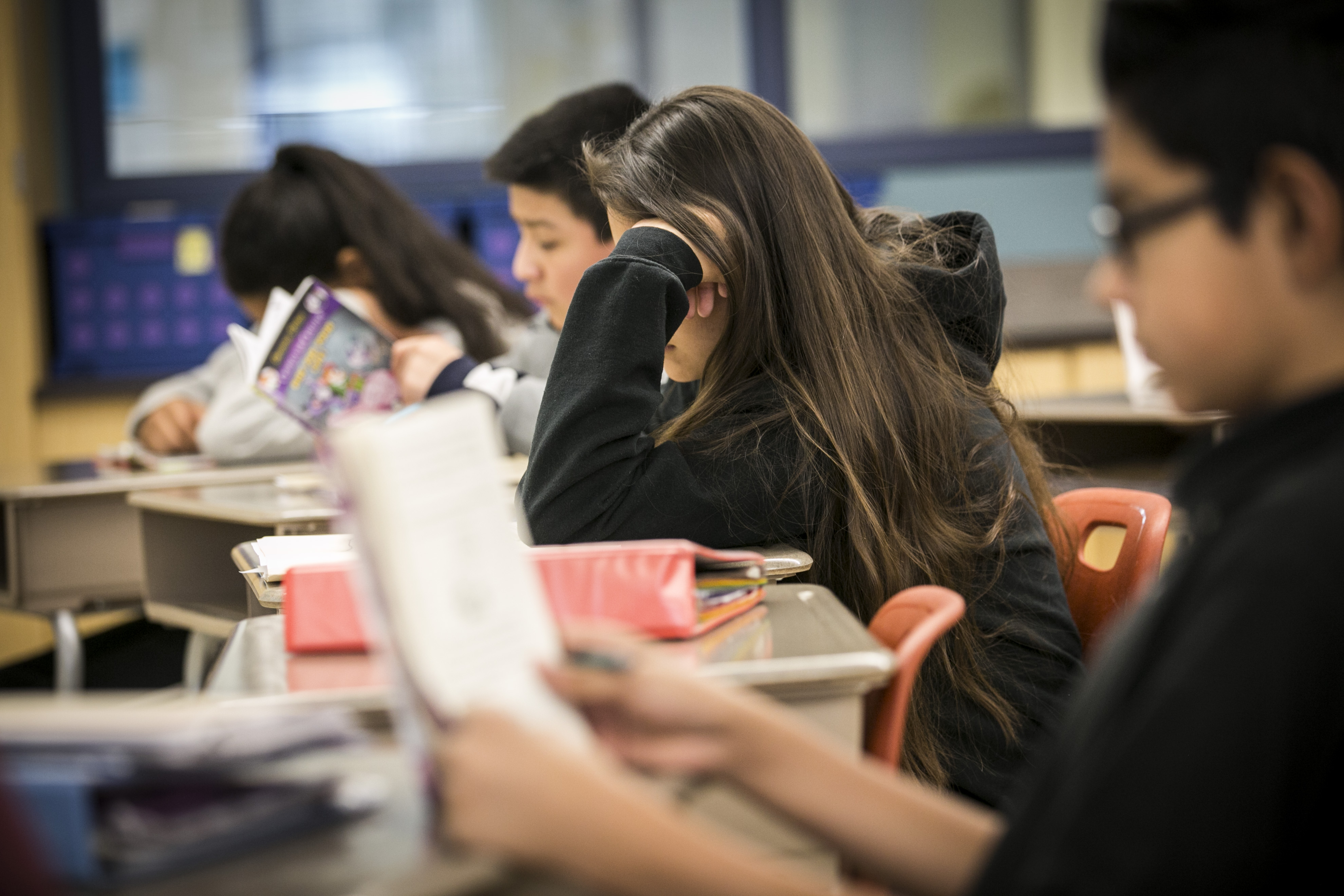
Here’s one way to describe 12-year-old Mahia: She has really long brown hair, a big smile, and she wears jeans and a well-washed T-shirt. She keeps a neat binder and likes to play soccer.
There's another, more bureaucratic way that school districts like Sheridan, southwest of Denver, use to describe students like Mahia: She’s a “multiple-category” kid.
Mahia speaks Spanish at home. Her family doesn’t have a lot of money. At school, Mahia sometimes has trouble processing information and organizing her thoughts at the same speed as her classmates. So she’s classified as a special education student. (Federal law protects the privacy of special education students like Mahia, which is not her real name.)
Mahia’s not alone at Sheridan’s Fort Logan Northgate. About 50 percent of the students are learning English as a second language; ninety percent qualify for free or reduced price lunches. That means their family's income is less than 185 percent of the federal poverty level, and more than 13 percent are identified as “special education” students — they have learning disabilities requiring special services or accommodations.
Those factors make Fort Logan distinctive. Only 11 other schools out of the state’s nearly 1,900 have such complicated student needs. But those numbers don’t define the school. In fact, compared to where it was a decade ago, the school is making good academic progress, according to state data. Teachers have high expectations, even for students who are years behind academically. Still, it’s a complex struggle to meet every student’s needs.
“Funding all of those and finding the right fit and the right way to meet all of those needs can be a huge challenge,” said Assistant Principal Amy Kolquist.
Looking For More Help
Mahia gets mostly Ds and Fs, but she’s like many kids. She wants to make her mom happy, and hopes to graduate next year at the end of eighth grade.
“I try to keep my grades good,” she said “But, like, I’m doing really bad and I don’t think I’m going to improve.”
Mahia’s bad grades are not for lack of trying. Her teachers all say she pays attention in class all day long, peering intently at the chalkboard and listening carefully.
In a recent math class, students learned how to calculate the surface area of shapes. Teacher Kimberly Kenton explained the problem clearly and slowly several times. The kids worked in pairs.
Mahia raised her hand for help and Kenton came over. But even with the help, Mahia was still confused, and before long, Kenton needed to move on to help other students.
“I don’t know,” Mahia said. “I just feel frustrated with all that work that we have to learn in that class. It makes me anxious.”

Mahia hasn’t fully mastered concepts from elementary school that are essential for her classroom work now. She was in a “pull out” special education class last year to master that material. She passed out of it and was ready to be independent. But sometimes, even with a special ed assistant circulating in the class, it’s not enough.
Teacher Kenton said she can’t give Mahia a higher grade because her knowledge level is grades behind. Kenton, trained to teach middle and high schoolers, struggles herself with teaching elementary concepts.
“I don’t have the tools,” Kenton said.
The district does get more funding for “multiple-category” kids like Mahia. The state of Colorado provides the Sheridan district with an extra $374 a year for each English language learner, $1,524 for each special education student, and $1,712 for each student qualifying for the federal free lunch program.
But Colorado funds English language learners and special education students at much lower rates than other states. After some federal money, districts must come up with the rest. It’s here that the Sheridan School District finds itself in a somewhat unique situation: It has many high-need students, but few of its own resources to help fill in the gap.
Sheridan’s contribution toward English language learner services makes up just 8 percent of the total.

Likewise, the amount the district spends on both special education and ELL students lags the state average. In the case of ELL, there’s a difference of more than $1,300 per student.

Help The Neediest, Or Everyone Else?
Civics class is another challenge for Mahia. For her, it can be hard to listen to her fast-talking teacher and take notes at the same time. But in a room that accommodates both special ed and language learners, as well as gifted and talented kids, teacher Michael DelBrocco said “We all have to kind of move at a pace.”
He knows Mahia has some cognitive challenges and organizing her thoughts into writing can be hard. More teachers would be a big help he said; at a previous job DelBrocco had a co-teacher.
“When you have two teachers — oh, it’s beautiful,” he said.
Sometimes Mahia goes in during the teacher’s lunch to ask a question or two. The school provides other accommodations to meet her special needs, like more time on assignments.
But those efforts don’t seem to be enough. And, Mahia admits, she doesn’t do her homework consistently. For her part, Mahia said a tutor would help her learn the material.

District Superintendent Michael Clough said it would be “virtually impossible” to provide that for every single student.
“You’re taking one pot to take care of the other,” he said. “And you’re taking away from students of need to serve the regular population. Or you’re taking ways from the regular education students to serve students with challenges. It is just very, very difficult when resources are so slim.”
He said at least 50 other kids in the middle school could benefit from one-on-one tutoring.
Kids Slip Through Cracks
Alice Collins is the only English language development teacher for the Fort Logan middle school. That means Collins works with more than 300 students.
Collins gets English language learners for 50 minutes a day. She said the state is working hard to keep up with new demands. But left to their own resources, districts like Sheridan can’t provide teacher support and professional development. As a result, Collins said, the younger teachers work many hours outside of class, tutoring and creating classroom materials to reach these students.
But many kids slip through the cracks.
“Teachers think because they can converse with them, they’re getting everything they’re saying. When in fact they’re really struggling with academic vocabulary and they sit their quietly while the content just passes right by them,” Collins said.

In Mahia’s English class, teacher Heather Royal thinks a lot about how to reach her students. She’s always finds ways to explain the meaning of words she thinks her students might not know.
“I’m never quite sure how to prepare for what they won’t know, because they all don’t know something different,” Royal said.
Her teachers say that as a special education student, Mahia gets more time to finish her work, assignments are shorter, and directions are repeated. Royal said having Mahia in an English and creative writing class has helped her make some improvements.
“But she is four grade levels below. So I don’t think getting her on grade level is going to be feasible,” Royal said.
Still, Royal sees a strong side in Mahia.
“It’s going to take more time and effort on her part than it will for other students. But when she is really focused and committed to doing something, she makes it happen,” Royal said.
“Turning The Titanic”
The school has come a long way in the past couple of decades. In 2010, Fort Logan was in the bottom 0.5 percent of schools in Colorado. In 2016, the middle-school grades achieved the state’s top performance rating because of strong academic growth.

School officials credit that to a $2.3 million federal grant that brought top-notch training, academic supports and other positions seven years ago. Though the money and other supports are gone, assistant principal Amy Kolquist said new systems are in place and they’re closing gaps.
“That’s turning the Titanic,” she said.
The school knows there are still missing pieces that could help a student like Mahia.
Mahia’s teachers say they need parents’ involvement, both to support learning at home and to make sure kids come to class. Mahia’s mom sometimes lets her stay home when she’s frustrated with school.
Mahia is not chronically absent, but even one day takes its toll, said math teacher Kimberly Kenton.
“[Parents] don’t understand that if you miss one day, we’re not going to just repeat it,” Kenton said. “And so missing a day, missing three days, missing a week, it’s a huge deal and a lot of times I don’t think it’s viewed as a huge issue.”
The district is still working on the attendance issue. But Fort Logan doesn’t have enough staff to work with families. In Sheridan, there’s no money for that so they’ve written a grant application.
“We are desperately searching to get more social workers and counselors and psychologists, finding the funding to do that, so we can meet all of their needs,” said assistant principal Kolquist.
Another counselor could help with a second piece of the puzzle, too: helping teachers help students with social emotional issues. Denver Public Schools, for instance, has money to focus on such challenges.
Kolquist hopes a counselor can build a bridge between teachers and students. The focus might be on cultural differences. Or Kolquist said it could give teachers new ways to help kids with time management and planning skills.
Kolquist believes the teachers are putting in 150 percent. But, she said, they also want to figure out what the “missing puzzle piece” is that will help them connect to students like Mahia.
For now, more staff is something Fort Logan’s staff can only dream about. It’s one more reminder of the inequities built into the way Colorado finances its schools.
Until then, Mahia and her teachers focus on her little wins. Like a positive comment from a teacher.
“My math teacher said I’m a hard worker,” Mahia said.
Or recently, in her first period class, she had to read an essay she wrote.
“I was shy, and I was reading too fast. But the good thing: I got a B because we were supposed to write two pages. But I wrote four pages,” she said excitedly.
That gave her a huge boost. So Mahia will keep working at her reading and her teachers will keep helping.









